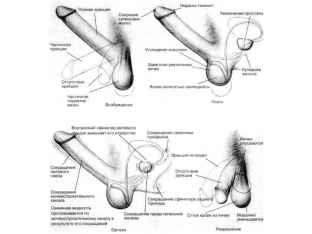Premature ejaculation is one of those sexual problems that men prefer to remain silent about. Representatives of the stronger sex who have such a problem can limit their sex life as much as possible, or not take the problem into account, while not being able to have a full-fledged sexual intercourse. But premature ejaculation is a urological pathology, and timely access to a urologist helps to effectively cope with the problem. What volume of diagnostic measures should the doctor take if a patient with such sexual dysfunction came to see him - read on estet-portal.com.
Methods of diagnosis and etiological factors of premature ejaculation
Premature ejaculation is one of the most common sexual dysfunctions. About 30% of men on the planet have faced this problem, but, unfortunately, only a small percentage of patients admit their disease and seek medical help. It is difficult for men with premature ejaculation to accept the fact that they are unable to fully engage in sexual intercourse. That is why the doctor must be very attentive and careful in dealing with such a patient. Anamnestic data play a very important role in correctly determining the cause of the disease and its effective treatment.
Premature ejaculation:
- etiological factors and classification of premature ejaculation;
- value of anamnestic data in the diagnosis of premature ejaculation;
- Steps of clinical examination of a patient with premature ejaculation.
Etiological factors and classification of premature ejaculation
Premature ejaculation is a polyetiological sexual disorder. There are two main groups of factors that can cause pathology:
- psychogenic factors: these include psychotrauma, features of sexual experience, defects in education, neurosis-like states or personality traits such as accentuation or psychopathy;
- organic factors: this group includes various disorders of the reproductive, endocrine and nervous systems, as well as delayed sexual development and chronic intoxication.
Depending on the duration of the frictional stage of sexual intercourse, 5 degrees of premature ejaculation are distinguished:
- 1 degree - ejaculation occurs 1-2 minutes after the onset of friction;
- 2 degree - ejaculation in 30-60 seconds;
- 3 degree - ejaculation in 15-30 seconds;
- grade 4 - ejaculation in less than 15 seconds;
- 5 degree - ejaculation occurs even before the onset of friction.

The value of anamnestic data in the diagnosis of premature ejaculation
A detailed history is the basis of the diagnostic process for premature ejaculation. During the conversation with the patient, the doctor must find out whether the man really has the problem of premature ejaculation, how pronounced it is, what causes could cause the pathology, and what other sexual dysfunctions the disease is combined with. The doctor receives all this information through the use of special questionnaires, analysis of the general and sexual history of the patient, communication with his sexual partner. It is important to discuss in detail with the patient not only the duration of the friction period, but also to assess the degree of his sexual desire, to clarify the characteristics of orgasm and the quality of erections.
Steps of clinical examination of a patient with premature ejaculation
Clinical examination includes a general assessment of the patient's condition, determination of his sexual constitution and examination of the genital organs. The aim of the clinical study is to detect urological pathology, in particular inflammatory diseases of the genital organs, as well as hypogonadism or delayed sexual development. The patient is undergoing ureteroscopy to exclude colliculitis or chronic urethroprostatitis. If urological pathology is excluded, hormonal studies are carried out and an endocrinologist is connected to the diagnostic process. If neither endocrine nor urological pathology is detected, the patient is subject to in-depth psychological and neurological examination.






Add a comment